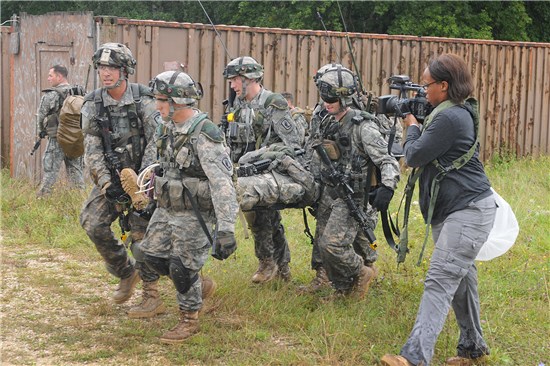 |
| Sgt. Marlene Duncan, 100th Mobile Public Affairs Detachment, Texas Army National Guard, right, role plays as a civilian media reporter during Operation Saber Junction held at Hohenfels in Nuremberg, Germany, Sept. 10, 2014. The 100th MPAD supported 17 countries, including the U.S., with realistic civilian media coverage; giving leadership a better understanding of how to work with civilian media in an operational environment. (U.S. Army National Guard photo courtesy of the 100th MPAD) |
Story by Sgt. Adrian Shelton
NUREMBERG, Germany (Sept. 12, 2014) - Public Affairs soldiers from 100th Mobile Public Affairs Detachment, Texas Army National Guard, in Austin, Texas, traveled to Nuremberg, Germany to capture the activities of thousands of troops in a joint exercise called Saber Junction, August 23 – Sept. 12, 2014.
Nearly 6,000 troops representing 17 countries participated in the multi-week international exercise at U.S. Army Garrison Hohenfels in Nuremberg. Often times, militaries from around the world work together to support a larger operation, such as seen during Operation Enduring Freedom. At the height of Operation Enduring Freedom, more than 20 different countries’ militaries joined forces to support operations and peace keeping missions. This type of multi-national training is designed to prepare militaries for large-scale contingency operations.
MPAD soldiers role-played as civilian media personnel to provide commanders from each country’s military; an understanding of how civilian journalism can shape the perception of war in public.
“It’s the best opportunity I’ve had so far in my military public affairs training to improve my skills at writing and taking photos,” said Spc. Michael Giles, print journalist with the MPAD. “It’s also given me a great opportunity to see how the public affairs structure works and why it’s an important part of military operations.”
Each day the service members headed into “The Box,” where role players, located in numerous mock cities provided information on military operations to the MPAD with the help of German translators.
“They created this world that we got to be a part of and have an impact based on what we reported,” said Army Sgt. Suzanne Carter, another print journalist with the MPAD. “The best part for me was figuring out their characters and who would support my side of the scenario.”
Annual training normally lasts only two weeks. But with an extra week, Army 1st Sgt. Merrion Lasonde directed her Soldiers to switch jobs for a day in order to become proficient in both skill sets. This meant the broadcast journalists would do the work required of print journalists and vice versa.
“In my mind, it was necessary,” Lasonde said. “They would find their groove and ultimately make the mission a success in their own individual way.”
Exercise leadership thought the MPAD provided an accurate representation of the media in a war zone.
“It’s greatly contributing to presenting an immersive picture of the operating environment for the Rotational Training Unit,” said James Dorough-Lewis Jr., the Operational Environment Training Specialist with the U.S. Army at the Joint Multinational Readiness Center (JMRC).
“We love having Reserve and National Guard elements come out to cover these exercises,” said Mark Van Treuren, media advisor, JMRC Public Affairs Office Operations Team. “We can’t do this without you.”
Army Sgt. Josiah Pugh contributed to story.